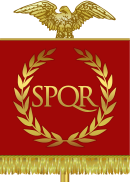
Back Ejército Imperial Romano Spanish Leger van het Romeinse Keizerrijk Dutch Quân đội Đế quốc La Mã Vietnamese
This article should specify the language of its non-English content, using {{lang}}, {{transliteration}} for transliterated languages, and {{IPA}} for phonetic transcriptions, with an appropriate ISO 639 code. Wikipedia's multilingual support templates may also be used - notably la for Latin. (February 2024) |
| Roman army | |
|---|---|
| Exercitus Romanus | |
 | |
| Active | 27 BC to 476 AD |
| Country | Roman Empire |
| Type | Army |
| Role | Land warfare |
| Size | 450,000 (211 AD) |
| Part of | Roman military |
| Nickname(s) | List of names |
| Equipment | List of equipment |
| Decorations | List of decorations |
| Commanders | |
| Commander-in-chief | Emperor (de facto) Consuls (de jure) |
 |
| Part of a series on the |
| Military of ancient Rome |
|---|
|
|
The Imperial Roman Army was the military land force of the Roman Empire from 27 BC to 476 AD,[1] and the final incarnation in the long history of the Roman army. This period is sometimes split into the Principate (27 BC – 284 AD) and the Dominate (284–476) periods.
Under Augustus (r. 27 BC – AD 14), the army consisted of legions, eventually auxilia and also numeri.[2] By the end of Augustus' reign, the imperial army numbered some 250,000 men, equally split between 25 legions and 250 units of auxiliaries. The numbers grew to a peak of about 450,000 by 211, in 33 legions and about 400 auxiliary units. By then, auxiliaries outnumbered legionaries substantially. From this peak, numbers probably underwent a steep decline by 270 due to plague and losses during multiple major invasions by the Germanic Tribal Folk. Numbers were restored to their early 2nd-century level of c. 400,000 (but probably not to their 211 peak) under Diocletian (r. 284–305).
After the Empire's borders became settled (on the Rhine-Danube line in Europe) by AD 68, virtually all military units (except the Praetorian Guard) were stationed on or near the borders, in roughly 17 of the 42 provinces of the empire in the reign of Hadrian (r. 117–138).
- ^ The Imperial Roman Army, Yann Le Bohec, Routledge, 28 Oct 2013
- ^ Goldsworthy, Adrian (2000). Roman Warfare